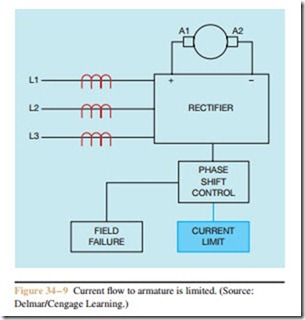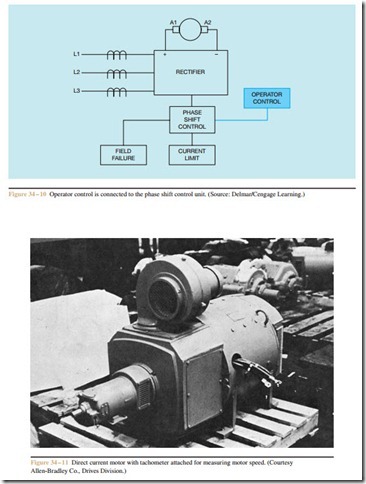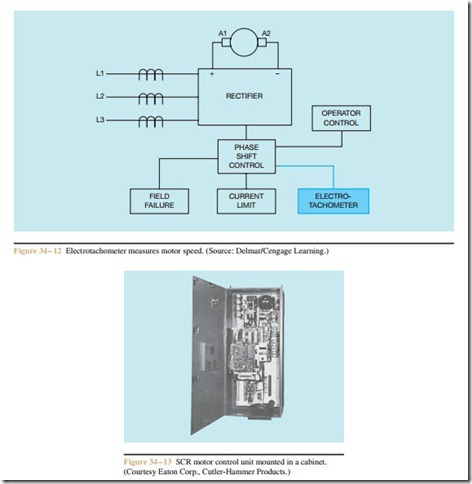Speed Control
The greatest advantage of using direct current motors is their variable speed characteristic. Although the ability to change motor speed is often desirable, it is generally necessary that the motor maintain a constant speed once it has been set. For example, assume that a DC motor can be adjusted to operate at any speed from 0 to 1800 rpm. Now assume that the operator has adjusted the motor to operate at 1200 rpm. The opera- tor controls are connected to the phase shift control unit (Figure 34 – 10). If the operator desires to change speed, a signal is sent to the phase shift control unit and the phase shift control permits the voltage applied to the armature to increase or decrease.
DC motors, like many other motors, will change speed if the load is changed. If the voltage connected to the armature remains constant, an increase in load
will cause the motor speed to decrease, or a decrease in load will cause the motor speed to increase. Since the phase shift unit controls the voltage applied to the armature, it can be used to control motor speed. If the motor speed is to be held constant, some means must be used to detect the speed of the motor. A very common method of detecting motor speed is with the use of an electrotachometer (Figure 34 – 11). An electro- tachometer is a small, permanent, magnet generator connected to the motor shaft. The output voltage of the generator is proportional to its speed. The output voltage of the generator is connected to the phase shift control unit (Figure 34 – 12). If load is added to the motor, the motor speed will decrease. When the motor speed decreases, the output voltage of the electrotachometer drops. The phase shift unit detects the voltage drop of the tachometer and increases the armature voltage until the tachometer voltage returns to the proper value.
If the load is removed, the motor speed will in- crease. An increase in motor speed causes an increase in the output voltage of the tachometer. The phase shift unit detects the increase of tachometer voltage and causes a decrease in the voltage applied to the armature. Electronic components respond so fast that there is almost no noticeable change in motor speed when load is added or removed. An SCR motor control unit is shown in Figure 34 – 13.
Review Questions
1. What electronic component is generally used
to change the AC voltage into DC voltage in large DC motor controllers?
2. Why is this component used instead of a diode?
3. What is a “freewheeling” or “kickback” diode?
4. Name two methods of sensing the current flow through the shunt field.
5. Name two methods of sensing armature current.
6. What unit controls the voltage applied to the armature?
7. What device is often used to sense motor speed?
8. If the motor speed decreases, does the output volt- age of the electrotachometer increase or decrease?
Related posts:
Incoming search terms:
- solid state dc drives
- solid state control of dc motor
- solid state speed control of dc motor
- solid state control
- Solid state control dc motor
- solid state dc motor control
- SOLID CONTROL EQUIPMENT
- solid state control of dc motor drive
- solid state control of dc motors
- solid state controlled drives
- solid state speed control dc motor
- solid state controller for motor dryive
- advantages of solid state devices using in speed control of d c drive
- Define solid state controlled drives
- solid state controllers for electical drives
- whats is a solid state speed controller
- solid state controls method
- solid state dc drive
- what is mean by solid state control dc motor
- the advantage of the tachometer speed control method for dc motors is that it senses the
- the advantage of the tachometer speed control method for d c motors is that it senses the
- the advantage of tachometer speed control method for dc motor it senses
- Solid state drvices for rlectric motor
- solid state method for dc motor
- solid state motor control
- speed control of dc motor using solid state control method
- solid state method for D c motor control
- solid state motor drive
- solid state speed control methods in dc motor
- solid state controller for motor drives
- basic idea of solid state device in controlling in DC motor
- dc drives in solid state drives
- dc motor solid state speed control
- defination of solid state control dc motor
- definition of solid state control of dc motor
- discusd solid state control of dc motor drive
- discuss solid state control of dc motor drive
- discuss the solid state control of dc motor drives
- about solid state speed control of dc motor
- solid state control drive
- solid state control method
- solid state control of dc drive
- solid state control of dc drives
- solid state control of dc machines
- solid state control of dc motor means
- solid state control of motor
- solid state control of motor drives electrucal 4vu
- advantage of solid-state device in controlling the speed of electric motor


